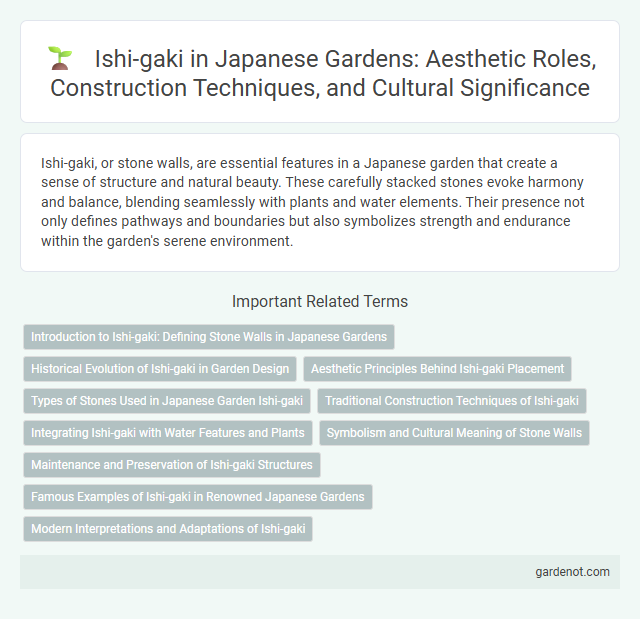Ishi-gaki, or stone walls, are essential features in a Japanese garden that create a sense of structure and natural beauty. These carefully stacked stones evoke harmony and balance, blending seamlessly with plants and water elements. Their presence not only defines pathways and boundaries but also symbolizes strength and endurance within the garden's serene environment.
Introduction to Ishi-gaki: Defining Stone Walls in Japanese Gardens
Ishi-gaki, traditional stone walls, serve as essential structural and aesthetic elements in Japanese gardens, reflecting centuries of craftsmanship. These meticulously arranged stones not only provide boundary and protection but also symbolize stability and harmony with nature. Their varied textures and organic forms contribute to the garden's serene ambiance, emphasizing balance and timeless beauty.
Historical Evolution of Ishi-gaki in Garden Design
Ishi-gaki, traditional stone walls in Japanese garden design, evolved significantly from defensive structures in feudal Japan to aesthetic elements symbolizing strength and harmony. These walls, carefully constructed using techniques like dry stacking or mortar bonding, reflect centuries of craftsmanship that blend natural materials with architectural precision. Historically, Ishi-gaki transitioned from practical fortifications in castles to integral garden features that enhance spatial composition and cultural symbolism.
Aesthetic Principles Behind Ishi-gaki Placement
Ishi-gaki, the stone walls in Japanese gardens, embody Wabi-Sabi aesthetics by emphasizing natural imperfection and asymmetry to create harmony with the surrounding environment. Each stone is carefully selected and positioned to balance visual weight and avoid uniformity, enhancing the garden's organic flow. This placement follows principles of Ma (negative space) and Shakkei (borrowed scenery), integrating the walls seamlessly into the landscape.
Types of Stones Used in Japanese Garden Ishi-gaki
Japanese garden ishi-gaki, or stone walls, primarily utilize granite, andesite, and basalt stones known for their durability and aesthetic appeal. Granite provides a rugged texture and natural color variation, enhancing the garden's organic look, while basalt offers a dark, dense surface that contrasts with greenery. Andesite stones are often chosen for their smooth, weather-resistant qualities, contributing both structural integrity and visual harmony in traditional Japanese landscape design.
Traditional Construction Techniques of Ishi-gaki
Ishi-gaki, traditional Japanese stone walls, are meticulously crafted using a dry-stacking method called nozura-zumi, where irregular natural stones fit tightly without mortar, ensuring durability and natural aesthetics. The technique emphasizes weight distribution and interlocking stone placement to resist earthquakes and erosion, reflecting centuries of perfected craftsmanship. These walls often incorporate flat stones on top, or unkei, to cap and stabilize the structure while blending seamlessly with the garden's organic design.
Integrating Ishi-gaki with Water Features and Plants
Ishi-gaki, traditional Japanese stone walls, harmoniously integrate with water features such as koi ponds and flowing streams, enhancing the garden's natural aesthetic. Carefully selected plants like moss, ferns, and bamboo soften the stone texture and create seamless transitions between rugged stone surfaces and tranquil water elements. This integration emphasizes balance and tranquility, fundamental principles of Japanese garden design.
Symbolism and Cultural Meaning of Stone Walls
Ishi-gaki stone walls in Japanese gardens symbolize strength, stability, and protection, reflecting the harmony between nature and human craftsmanship. These walls often represent the boundary between sacred and mundane spaces, embodying cultural values of respect and mindfulness. Their carefully arranged stones convey a timeless aesthetic that honors resilience and the impermanence of life.
Maintenance and Preservation of Ishi-gaki Structures
Maintenance and preservation of Ishi-gaki structures in Japanese gardens involve regular inspection and repair of stone walls to prevent erosion and structural damage. Traditional techniques such as careful stone repositioning and using natural materials for reinforcement ensure the longevity and authenticity of these historical features. Expert craftsmanship combined with sustainable conservation practices maintains the aesthetic and cultural significance of Ishi-gaki over time.
Famous Examples of Ishi-gaki in Renowned Japanese Gardens
The Ishi-gaki, traditional stone walls used in Japanese gardens, exemplify craftsmanship in locations like Kenrokuen in Kanazawa and Koko-en in Himeji. Kenrokuen's Ishi-gaki walls showcase intricate stone placement that enhances the garden's historic ambiance, while Himeji's Koko-en features robust walls reflecting samurai-era fortifications. These stone walls not only provide structural support but also symbolize strength and harmony within the garden's natural landscape.
Modern Interpretations and Adaptations of Ishi-gaki
Modern interpretations of Ishi-gaki incorporate innovative materials and contemporary construction techniques while preserving traditional Japanese stone masonry principles. Designers blend natural stone with concrete and steel to create durable, aesthetically pleasing retaining walls that harmonize with minimalist garden layouts. These adaptations enhance structural functionality and offer new visual textures, reflecting the evolving role of Ishi-gaki in urban and residential Japanese garden designs.
Ishi-gaki Infographic

 gardenot.com
gardenot.com